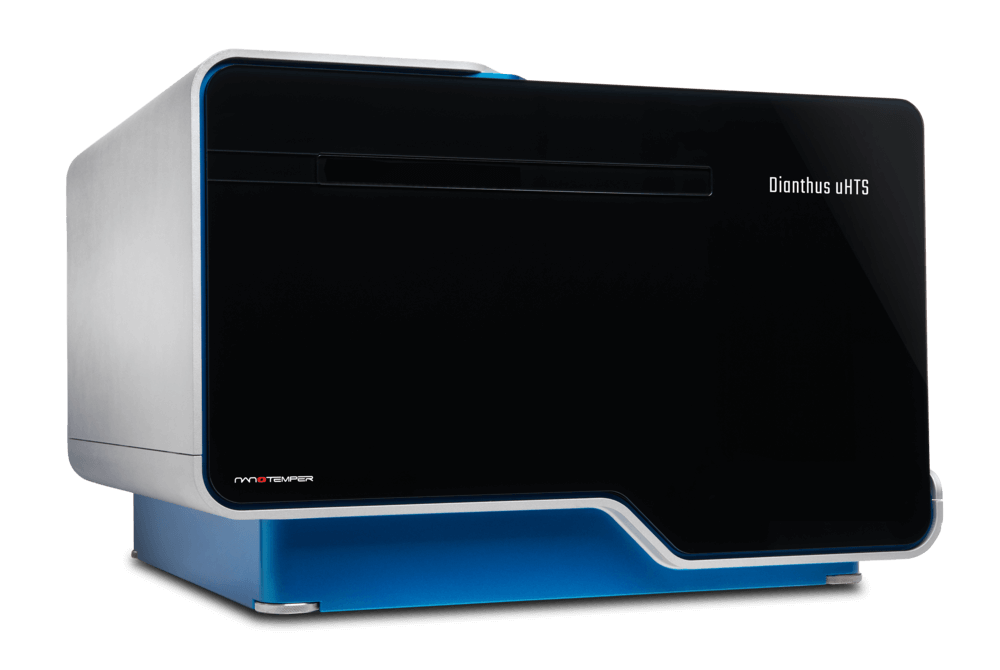Measure a 1536-well plate in only 8 minutes. Dianthus uHTS, with breakthrough Spectral Shift technology
Biophysical methods have always had one weakness preventing them from being viable for primary screening — until now. Meet Dianthus uHTS, the only biophysical affinity measurement platform with the speed suitable for ultra-high-throughput screening.

Dianthus uHTS measures a 1536-well plate in only 8 minutes, and can be fully automated via an open gRPC framework. Data is delivered in whatever format you need, making it easy to integrate into your existing analysis workflow. No microfluidics minimizes maintenance, letting the instrument run 24/7. Dianthus uHTS does not get in the way, empowering scientists to move faster than ever before.
Use biophysical tools earlier to de-risk your drug discovery pipeline
Characterize interactions without prior knowledge of binding sites
Drug targets rarely have only one binding site, and with the increasing prevalence of induced proximity modalities that rely on cooperativity to drive ternary complex formation, it is extremely difficult to predict where a molecule will bind your target. Dianthus uHTS does not require prior knowledge of the binding site to collect data, meaning you can identify binders that would be missed during HTRF assays.
Get actionable results without spending too much time on assay development
Spectral Shift technology only needs one binding partner to be labeled in order to detect an interaction, greatly simplifying assay development. Additionally, measurements happen in-solution, immobilization free, and independent of mass changes upon binding, allowing for more flexibility in assay design.
Rely on a single modality for both primary screening and lead validation
Spectral Shift technology is already proven as a trusted method for lead validation and optimization, and now it can be used for primary screening as well. Using the same method for primary screening and lead validation negates the need for another round of costly assay development, until you are ready for orthogonal measurements.
Beat common concerns encountered with other technologies
Automate your affinity screening campaigns
Get hours of uninterrupted and unattended operation with a format that’s compatible with any automation solution.
Measure the broadest range of affinities
Dianthus uHTS detects a wide range of binding affinities — picomolar to millimolar — so you catch very strong and weak binders.
Characterize in solution, no immobilization required
Analyzing interactions in close-to-native conditions is ideal, especially when dealing with challenging targets. Never worry about negatively impacting your target’s binding site or lacking control over equilibrium conditions, since measurements are done in solution.
Consume small amounts of target and compounds
Every little bit counts. Saving on costly samples and library compounds means you can do more screening campaigns or projects.
Dianthus uHTS is your trusted screening platform from hit ID to Lead Validation
Hit Identification
Finding true hits faster is the most important step in making your drug discovery workflow efficient. With Dianthus uHTS, you’ll find hits quickly and move on to hit validation confidently, whether it’s fragment-based or small molecule single-dose screening.
Lead Validation
Spectral Shift has already been proven as a trusted method for lead validation. Dianthus uHTS lets you measure in 1536 or 384-well plates, giving you the flexibility you need to validate your hits regardless of library size.
Ensure your success with Spectral Shift
Dianthus uHTS relies on Spectral Shift technology. The process is actually pretty simple: label one binding partner with a fluorophore, then mix a fixed amount of it with a dilution series of the ligand. After excitation at 590nm of the mix, the binding events are detected as shifts of spectra towards either blue or red. The detection of spectral shifts is achieved through dual-wavelength detection at exactly 650nm and 670nm in an isothermal environment — this makes Dianthus uHTS precise enough to detect very subtle shifts, even when taking extremely rapid measurements.
Then the Kd is calculated by plotting the ratios of the fluorescence intensities from the two wavelengths against the ligand concentration.


Get consistent results with high-quality consumables

Get consistent results with high-quality consumables
Get the high quality and consistency you expect from consumables when finding and validating hits. Dianthus 1536-well plates have all the features needed for the best performance and user experience:
- Specific well geometry optimized for Spectral Shift measurements, while still being compatible with existing automation solutions
- Manufactured with a proprietary coating that prevents protein from sticking to the wells
- Rigorous QC testing to ensure consistency from well to well
You’ll also want to use a labeling kit to label your proteins or peptides with fluorophores selected for their sensitivity to binding events — so you get the best results with Spectral Shift.
